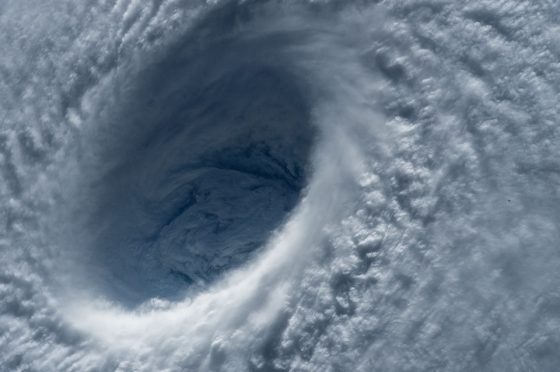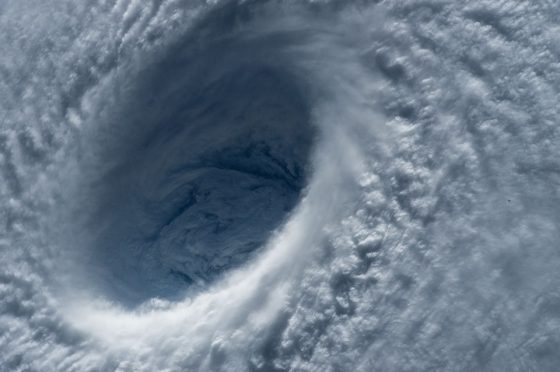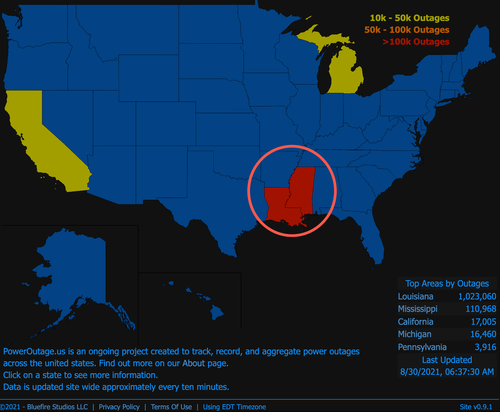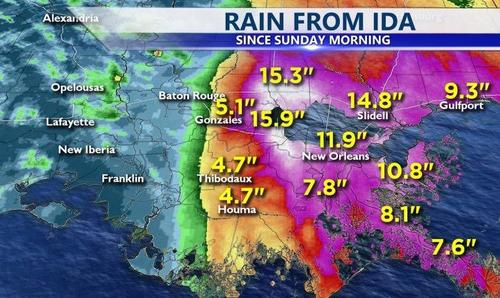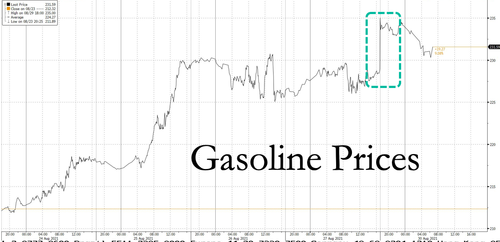This article was originally published by Tyler Durden at ZeroHedge.
More than a million people are without power as Hurricane Ida battered New Orleans and the Louisiana coast on Sunday.
Ida was one of the strongest hurricanes on record, in terms of wind speed and pressure, to make landfall in Louisiana. The timing of landfall was on the 16th anniversary of Katrina, a Category 3 hurricane that swamped the Gulf Coast with torrential rains.
After making landfall early Sunday afternoon, Ida has since been downgraded to a tropical storm and was moving eight mph with the storm’s eye about 50 miles north-northeast of Baton Rouge. Winds have dramatically decreased and sustained around 60 mph.
Officials warned yesterday of “life-threatening” floods and significant storm surges across Louisiana and Mississippi. Sixteen states from Mississippi to New Jersey are under a flash flood advisory through the week.
LaPlace, Louisiana, recorded the highest rainfall of around 15 inches. Flash flood advisories remain in effect for the area.
So far, more than 1 million homes and businesses are without power and another 100,000 in Mississippi. It was reported that 200,000 were without power in New Orleans due to catastrophic damage to transmission lines for the metro area.
New Orleans is also experiencing technical difficulties with its emergency communications network.
“If you find yourself in an emergency, please go to your nearest fire station or approach your nearest officer,” the Orleans Parish Communication District announced via Twitter early Monday. “We will update you once this issue has been resolved.”
At this time, 9-1-1 is experiencing technical difficulties.
If you find yourself in an emergency, please go to your nearest fire station or approach your nearest officer. We will update you once this issue has been resolved. Thank you. pic.twitter.com/BE2AxwFuDa— OPCD911 (@opcd911) August 30, 2021
Ahead of Ida’s landfall, President Biden approved a federal disaster declaration for Louisiana to assist with recovery efforts. On Monday morning, the storm’s impact has yet to be fully assessed. The storm has been responsible for at least one death.
Millions along the Gulf Coast are waking up to destruction and flooding after Hurricane Ida made landfall on Sunday. The powerful storm left the entire city of New Orleans without power. @alroker has the latest. pic.twitter.com/qhF0J51C4Q
— TODAY (@TODAYshow) August 30, 2021
At least one person dead as Hurricane Ida battered the US state of Louisiana and plunged New Orleans into darkness.
16 years to the day after Hurricane Katrina devastated the city. pic.twitter.com/BWLS5XUMRc
— NWFalert (@NWFalert) August 30, 2021
Video of the heavily damaged apartments in Lockport, LA. #HurricaneIda #lawx pic.twitter.com/wAIVVVQ9uK
— Brian Emfinger (@brianemfinger) August 30, 2021
“This is the kind of damage that people in New Orleans are waking up to. This building was over 100 years old, survived Katrina, dozens of other hurricanes. But #Ida‘s wind gusts here were almost 100 mph and turned it into a pile of bricks.” — @OmarVillafranca in New Orleans pic.twitter.com/j4Htd2G0lT
— CBS This Morning (@CBSThisMorning) August 30, 2021
Hurricane Ida knocks out power to New Orleans and causes “catastrophic transmission damage” that leaves city in the dark. @VictorOquendo reports. https://t.co/ieJf4DR2yW pic.twitter.com/dM2lpUCrbB
— Good Morning America (@GMA) August 30, 2021
Here is a look at some of the damage from Hurricane Ida in New Orleans. An awning was ripped off a building in the French Quarter Sunday. pic.twitter.com/LToy2yvHPd
— KCTV5 News (@KCTV5) August 30, 2021
On the energy front, oil explorers bracing for the storm have already halted more than 1.74 million barrels of daily crude production. Royal Dutch Shell Plc, BP Plc, and others closed platforms and evacuated crews last week.
Gasoline futures this morning soared above 4% on the prospects of refinery disruptions across Louisiana and surrounding states.
Oil reversed gains as it appears offshore rigs may have dodged the storm, and OPEC+ producers will host a meeting on Wednesday
“The market will be looking at the product stocks and the risks of onshore damage from Ida,” said Matt Stanley, a senior broker at Star Fuels in Dubai.
“Now that the storm has made landfall, it looks like the worst is past for the offshore platforms, and over the next couple of days, operators can look at getting those back up.”
Refiners, including Valero Energy Corp., shuttered 12% of its oil-processing capacity due to the storm.
Colonial Pipeline Co., the controller of the largest fuel network in the US, had to idle its fuel distribution system from Texas to the Northeast.
The storm also positively impacted natural gas futures which traded at levels not seen since 2018 as producers in the Gulf of Mexico have shut 93.8% of natgas output.
Statistically speaking, we should remind readers that the busiest part of the Atlantic hurricane season is already underway.
The post ‘911’ System Offline, 1 Million Plus Without Power After Hurricane Ida Slams Gulf Coast first appeared on SHTF Plan – When It Hits The Fan, Don’t Say We Didn’t Warn You.


